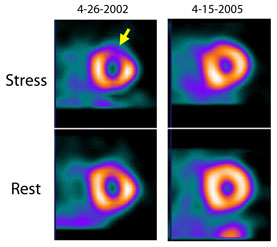Medicine and management: hits from Hospital Medicine
An expert discusses managing aortic dissection as a disease for life. Also, highlights from Hospital Medicine 2009 discuss caring for the pregnant patient, documenting care for the best reimbursement and ways to improve handoffs from shift to shift.
CHICAGO—Hospital Medicine 2009 sessions were a lot like hospitalist's daily schedules: varied, detailed and wide-ranging. ACP Hospitalist staff highlighted the best of the scientific and administrative management sessions.
Managing aortic dissection

Kim A. Eagle, FACP, said that hospitalists need to stress to patients that aortic dissection is a disease for life.
Dr. Eagle, director of the University of Michigan Cardiovascular Center, noted that beta-blockers are the mainstay of therapy despite a lack of randomized, controlled trials. He also recommended angiotensin-converting enzyme (ACE) inhibitors and angiotensin receptor blockers (ARB) in addition to beta-blockers, based in part on the results of the Jikei Heart Study, and said that statins are indicated in patients with atherosclerosis.
Over the long term, patients who've had aortic dissection should aim for a heart rate less than 60 beats per minute. Blood pressure should be controlled to less than 120/80 mm Hg, or “as low as you can get it and not have hypoperfusion symptoms,” Dr. Eagle said. Clinicians should order imaging studies to watch for aneurysm formation one, three, six, and 12 months after the initial event.
Patients should be told to avoid lifting more than 30 or 40 pounds and should not play contact sports, such as soccer or football. They should know to seek urgent medical help if they have any sudden onset of pain in their chest, back or abdomen, Dr. Eagle noted. Also, they need to understand that their medications are vital to their survival.
“When they run out of medicines, they are threatening their lives,” he said. “So they can't run out of their medicines.”
Caring for the pregnant patient
Although hospitalists often haven't had specific training in consulting on a pregnant patient, every hospitalist is likely to encounter a pregnant patient at some point during his or her career, according to Anna Kho, MD.
“Some OB doctors don't feel comfortable taking care of internal medicine illnesses in pregnant patients, and they will look to us for guidance and recommendations about what to do to ensure the patient has the best care possible,” said Dr. Kho, assistant professor of medicine at Emory University School of Medicine in Atlanta. She outlined some key points for treating pregnant women:
- When considering drug therapy, think about whether lifestyle changes can be recommended, and whether there's a similar drug that's safer. Avoid new medications, think twice when prescribing medication in the first trimester, and never use a drug without an indication.
- Chronic hypertension doesn't need to be treated until the diastolic blood pressure goes above 105 mm Hg. Methyldopa is the drug of choice for hypertension; avoid ACE inhibitors and ARBs, because they can lead to renal agenesis and fetal death.
- Pregnant women are at higher risk of venous thromboembolism, the leading cause of non-OB maternal mortality in the U.S. To diagnose, look for unilateral leg edema and pain. Ninety percent of deep venous thromboses occur on the left side in pregnant women. To treat, use unfractionated heparin or low-molecular-weight heparin. Warfarin should be avoided due to extreme teratogenicity.
- Only insulin is recommended in the treatment of diabetes in pregnancy.
Documenting care
Bryce Gartland, MD, of Emory University offered hospitalists practical advice on improving their clinical documentation. He first provided a brief review of the 2008 change from CMS-Diagnosis Related Groups (DRG) to Medicare Severity DRGs (MS-DRGs).
Under the new system, diagnoses are now classified as being with or without complications/comorbidities (CCs) or major complications/comorbidities (MCCs). Nonspecific codes can increase a facility's costs: The reimbursement for heart failure and shock with MCC is $8,218 versus $3,959 for heart failure without CC or MCC. (For more on this, see ACP Hospitalist ‘s coding column. )
“Documentation of this has astonishing financial impact for hospitals,” Dr. Gartland said. He offered the following tips to optimize documentation:
- Be specific. “If you're not specific, it usually doesn't correspond to a specific code with an ICD-9.”
- Emphasize acute diseases and chronic diseases with acute exacerbations, those that are end-stage or those with extensive disability. “For those who like acronyms, we've come up with ACE3,” he said.
- Remember that “In the coding world, the words ‘possible,’ ‘probable,’ ‘likely,’ and ‘suspected’ all count.”
- Don't forget the small stuff, such as electrolytes and nutrition status.
Accurate coding is linked to quality, Dr. Gartland said, because failing to accurately document comorbidities or complications makes the risk for death look lower than expected. Accurate and complete documentation, on the other hand, helps align expected and accurate mortality.
“Clinical language does not equal coding language,” Dr. Gartland said. “We have to retrain our brains to understand that we actually have to document not only to convey knowledge from one care team member to another but also to make sure that coding understands specifically what we're doing.”
Improving handoffs
Vineet Arora, FACP, discussed the “worldwide issue” of errors in handoffs and how these care transitions can be improved.
When speaking to a colleague during a shift or service change, it's important to include “anticipatory guidance”—what may happen overnight and what the incoming provider can do about it. Always use precise language, and give priority to ill patients first, said Dr. Arora, associate program director of internal medicine residency at the University of Chicago. Written signouts should also be used, and should be more detailed than the verbal signout.
The key information to include in a written handoff can be remembered via the mnemonic ANTICipate, she said:
- Administrative data (for example, name, gender, room number, admission date);
- New information (for example, chief complaint, updated medication list, current baseline status, recent procedures and events);
- To-do list, including the use of if-then statements and warnings about incoming information like lab results;
- Illness (how sick is the patient);
- Contingency planning (for example, what may go wrong and how to handle it, what has or hasn't worked before, and code status.)
“A frightening statistic from our (research) is that 80% of daily signouts from patients contain at least one medication omission, and more than 50% of those are potentially harmful. Nearly 40% of signouts contain a commission, i.e., a medication is left on that shouldn't be,” Dr. Arora said. “This can easily be avoided.”





